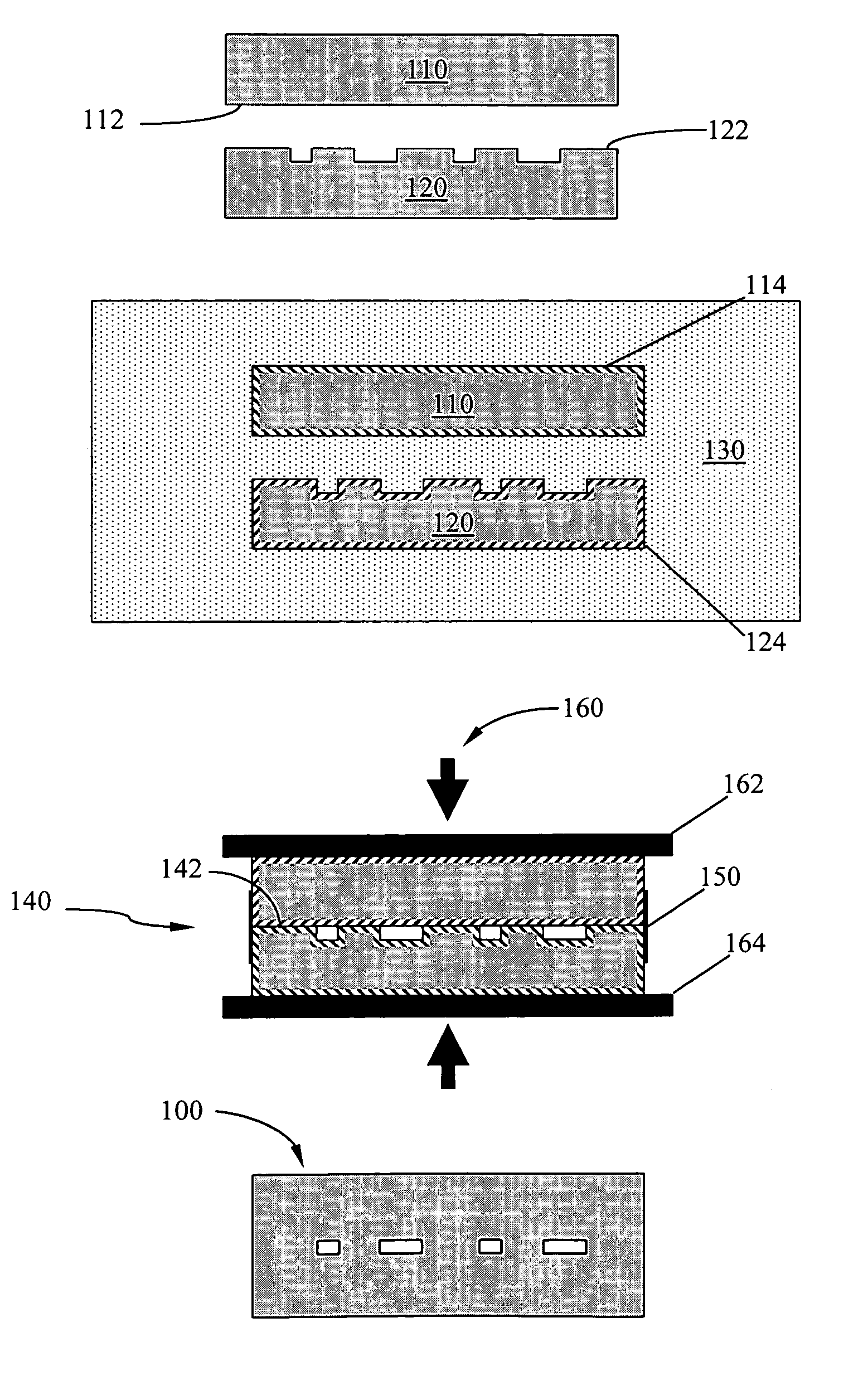Bonding thermoplastic polymers
a thermoplastic polymer and bonding technology, applied in the direction of microstructural device assembly, adhesive process with surface pretreatment, other domestic articles, etc., can solve the problem of fluid-tight bond between the two plaques, and achieve uniform surface properties
- Summary
- Abstract
- Description
- Claims
- Application Information
AI Technical Summary
Benefits of technology
Problems solved by technology
Method used
Image
Examples
example 1
[0079]Two injection-molded ZEONOR® 1060 coupons are rinsed with acetone and isopropanol, and then dried under a nitrogen stream. The first coupon is immersed for 15 min in a solution consisting essentially of 80 wt % ethanol and 20 wt % decahydronaphthalene at 21° C. The second coupon is immersed in the same solution for 30 s at 21° C. Following immersion, the coupons are rinsed with isopropanol for approximately 30 s, then dried under a gentle nitrogen stream. The two coupons are mated and KAPTON® tape is applied to the perimeter, covering the bond line. The mated coupons are placed between pressure plates and the assembly is inserted between the platens of a CARVER® press. The platens are adjusted until the top platen just touches the top of the assembly; at this point, the press is heated to 60° C. over the course of 15 min. Following heating, the assembly is loaded at 200 psi for 25 min. The press is cooled with running water (˜10 min.) to less than 27° C.; the bonded coupon is ...
example 2
[0081]Two injection-molded ZEONOR® 1060 coupons are rinsed with acetone and isopropanol, then dried under a nitrogen stream. The first coupon is immersed for 6 min in a solution consisting essentially of 80 wt % acetone and 20 wt % decahydronaphthalene at 21° C. The second coupon is immersed in the same solution for 30 s at 21° C. Following immersion, the coupons are rinsed with isopropanol for approximately 30 s, and then dried under a gentle nitrogen stream. The two coupons are mated and KAPTON® tape is applied to the perimeter, covering the bond line. The mated coupons are placed between pressure plates and the assembly is inserted between the platens of a CARVER® press. The platens are adjusted until the top platen just touches the top of the assembly; at this point, the press is heated to about 60° C. over the course of 15 min. Following heating, the assembly is loaded at 200 psi for 25 min. The press is cooled with running water (˜10 min.) to less than 27° C.; the bonded coupo...
example 3
[0083]Two injection-molded ZEONOR® 1060 coupons are rinsed with acetone and isopropanol, and then dried under a nitrogen stream. The first coupon is immersed for 3 min in a room ambient solution consisting essentially of 75 wt % methanol and 25 wt % cyclohexane. The second coupon is immersed in the same solution for 30 s at 21° C. Following immersion, the coupons are dried under a gentle nitrogen stream, then immediately mated. The two coupons are mated and KAPTON® tape is applied to the perimeter, covering the bond line. The mated coupons are placed between pressure plates and the assembly is inserted between the platens of a CARVER® press. The platens are adjusted until the top platen just touches the top of the assembly; at this point, the press is heated to 60° C. over the course of 15 min. Following heating, the assembly is loaded at 200 psi for 25 min. The press is cooled with running water (˜10 min.) to less than 27° C.; the bonded coupon is removed. Coupons are then baked in...
PUM
| Property | Measurement | Unit |
|---|---|---|
| wt % | aaaaa | aaaaa |
| wt % | aaaaa | aaaaa |
| bond-promoting temperatures | aaaaa | aaaaa |
Abstract
Description
Claims
Application Information
 Login to View More
Login to View More - R&D
- Intellectual Property
- Life Sciences
- Materials
- Tech Scout
- Unparalleled Data Quality
- Higher Quality Content
- 60% Fewer Hallucinations
Browse by: Latest US Patents, China's latest patents, Technical Efficacy Thesaurus, Application Domain, Technology Topic, Popular Technical Reports.
© 2025 PatSnap. All rights reserved.Legal|Privacy policy|Modern Slavery Act Transparency Statement|Sitemap|About US| Contact US: help@patsnap.com



